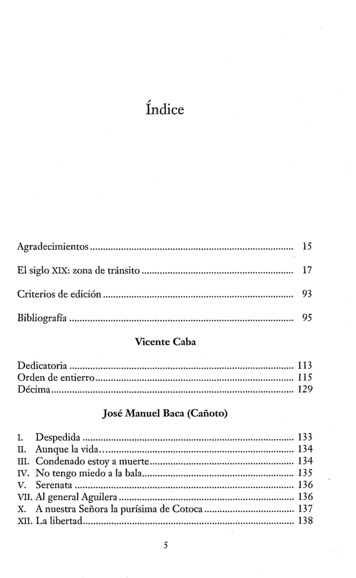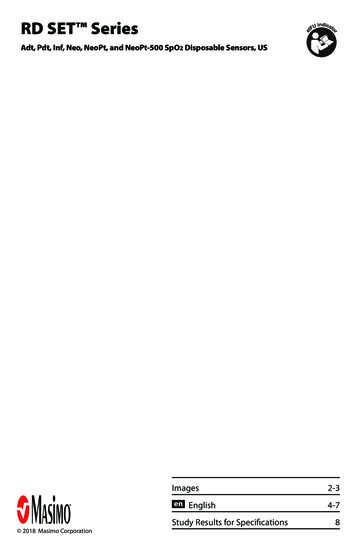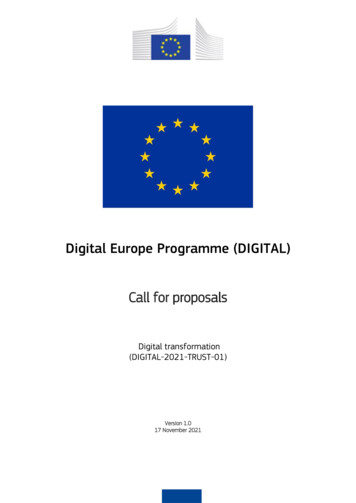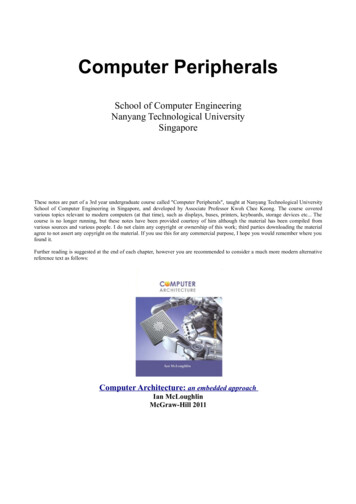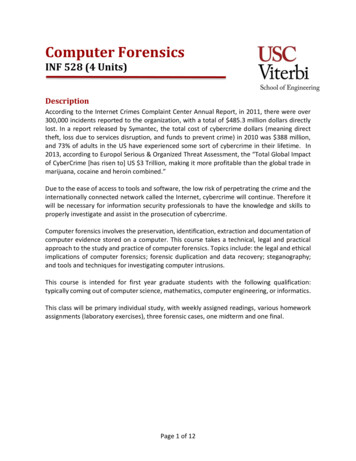
Transcription
Computer ForensicsINF 528 (4 Units)DescriptionAccording to the Internet Crimes Complaint Center Annual Report, in 2011, there were over300,000 incidents reported to the organization, with a total of 485.3 million dollars directlylost. In a report released by Symantec, the total cost of cybercrime dollars (meaning directtheft, loss due to services disruption, and funds to prevent crime) in 2010 was 388 million,and 73% of adults in the US have experienced some sort of cybercrime in their lifetime. In2013, according to Europol Serious & Organized Threat Assessment, the “Total Global Impactof CyberCrime [has risen to] US 3 Trillion, making it more profitable than the global trade inmarijuana, cocaine and heroin combined.”Due to the ease of access to tools and software, the low risk of perpetrating the crime and theinternationally connected network called the Internet, cybercrime will continue. Therefore itwill be necessary for information security professionals to have the knowledge and skills toproperly investigate and assist in the prosecution of cybercrime.Computer forensics involves the preservation, identification, extraction and documentation ofcomputer evidence stored on a computer. This course takes a technical, legal and practicalapproach to the study and practice of computer forensics. Topics include: the legal and ethicalimplications of computer forensics; forensic duplication and data recovery; steganography;and tools and techniques for investigating computer intrusions.This course is intended for first year graduate students with the following qualification:typically coming out of computer science, mathematics, computer engineering, or informatics.This class will be primary individual study, with weekly assigned readings, various homeworkassignments (laboratory exercises), three forensic cases, one midterm and one final.Page 1 of 12
ObjectivesThe nature of digital forensics lends itself to a more applied understanding and conceptdemonstration than some purely theoretically-based course. Therefore, students areexpected to not only understand the principles involved in forensic analysis and investigation,but upon leaving the course, be able to apply these in practice. A summary outline ofobjectives includes:- Demonstrate an understanding of the legal and ethical implications of computerforensics and investigations- Demonstrate an understanding of evidence preservation and authentication- Understand how to analyze an email header- Understand how to analyze stenographic evidence- Understand the basics of file systems- Understand the specifics of FAT32 and NTFS file systems- Understand how to perform a forensic analysis of a Windows XP and Windows 7system- Demonstrate how to draft a digital forensics report for the appropriate audienceMethods of TeachingThe primary teaching methods will be lecture, demonstrations, assignments, and full caseinvestigations. Students are expected to perform directed self-learning outside of class whichencompasses among other things a considerable amount of literature review. The students areexpected to take an active role in the course. Students will attend lectures, complete regularexams to reinforce the concepts taught and highlight weaknesses in grasp and presentation,complete assigned projects to apply and illustrate the concepts in an applied manner (throughlab exercises and case investigations).Students will be given ten laboratory exercises that will require work outside of class tocomplete. There will be a series of steps that will be required to execute, an analysis of whatwas performed, and an explanation of the results. These laboratory exercise will be crucial tobeing able to complete the cases.Students will be given three full cases to demonstrate their understanding of how to completea forensics investigation. Students will be provided with the case background and imageddrive. After completing the investigation, students will be required to draft a forensic reportappropriate for submission to a court of law, which will be graded appropriately. Each casewill require approximately twenty hours to complete.Page 2 of 12
InstructorContacting theInstructorOffice HoursLab AssistantsLecture/LabRequired TextbooksJoseph s Forensic Analysis Toolkit, 3rd Edition. Carvey.ISBN: 1597497274NOTE: The 3rd edition of the textbook covers Windows 7. The 4th edition covers Windows 8,and the 2nd edition covers Windows XP. I have all three and they have different material. Forthis course, you need the 3rd edition.Hacking Exposed: Computer Forensics, Second Edition. Davis, Philipp, and CowenISBN: 0071626778Recommended Textbooks (For This Course and the Future)System Forensics, Investigation and Response. Easttom.ISBN: 1284031055Incident Response & Computer Forensics, Third Edition. Luttgens, Pepe and Mandia.ISBN: 0071798684File System Forensic Analysis. CarrierISBN: 0321268172WebsiteAll course material will be on Desire2Learn (courses.uscden.net)GradingGrading will be based on percentages earned in assignments, cases, and exams. The followingis the grade breakdown.Lab Exercises (10)30% (3% each)In the event of fewer labs during the semester, they will beweighted evenly to add up to 30% of your final gradeCase Reports (3)45% (15% each)Case descriptions provided towards the end of the syllabusMidterm Exam10%Final Exam15%Total100%Page 3 of 12
Grading ScaleThe following shows the grading scale to be used to determine the letter grade.94% and aboveA90% - 93%A87% - 89%B 84% - 86%B80% - 83%B77% - 79%C 74% - 76%C70% - 73%C67% - 69%D 64% - 66%D60% - 63%D60% and belowFPoliciesNo make-up exams (except for documented medical or family emergencies) will be offered norwill there be any changes made to the Final Exam schedule.The labs will be posted on Blackboard under the “Assignments” section. Each lab will includeinstructions, a due date, and a link for electronic submission. Labs must be submitted usingthis link.Cases will be posted on Blackboard, and the forensic drive images will be distributed duringclass. Case reports must be submitted as a hard copy on or before the due date and time.It is your responsibility to submit your assignments on or before the due date. Assignmentsturned in up to 24 hours late will have 25% of the total points deducted from the graded score.Assignments turned in between 24 and 48 hours late will have 50% of the total points deductedfrom the graded score. After 48 hours, submissions will not be accepted and will be recordedas a 0.All labs must be submitted through blackboard. All cases must be turned in as a hard copy. Donot email the labs or cases to the TAs, graders or instructor.Incomplete and Missing GradesExcerpts for this section have been taken from the University Grading Handbook, located ok/index.html. Please see the link formore details on this and any other grading concerns.A grade of Missing Grade (MG) “should only be assigned in unique or unusual situations forthose cases in which a student does not complete work for the course before the semesterPage 4 of 12
ends. All missing grades must be resolved by the instructor through the Correction of GradeProcess. One calendar year is allowed to resolve a MG. If an MG is not resolved [within] oneyear the grade is changed to [Unofficial Withdrawal] UW and will be calculated into the gradepoint average a zero grade points.A grade of Incomplete (IN) “is assigned when work is no completed because of documentedillness or other ‘emergency’ occurring after the twelfth week of the semester (or 12th weekequivalency for any course scheduled for less than 15 weeks).”Academic IntegrityThe University, as an instrument of learning, is predicated on the existence of an environmentof integrity. As members of the academic community, faculty, students, and administrativeofficials share the responsibility for maintaining this environment. Faculties have the primaryresponsibility for establishing and maintaining an atmosphere and attitude of academicintegrity such that the enterprise may flourish in an open and honest way. Students share thisresponsibility for maintaining standards of academic performance and classroom behaviorconducive to the learning process. Administrative officials are responsible for theestablishment and maintenance of procedures to support and enforce those academicstandards. Thus, the entire University community bears the responsibility for maintaining anenvironment of integrity and for taking appropriate action to sanction individuals involved inany violation. When there is a clear indication that such individuals are unwilling or unable tosupport these standards, they should not be allowed to remain in the University.” (FacultyHandbook, 1994:20)Academic dishonesty includes: (Faculty Handbook, 1994: 21-22)Examination behavior – any use of external assistance during an examination shall beconsidered academically dishonest unless expressly permitted by the teacher.Fabrication – any intentional falsification or invention of data or citation in an academicexercise will be considered a violation of academic integrity.Plagiarism – the appropriation and subsequent passing off of another’s ideas or words as one’sown. If the words or ideas of another are used, acknowledgment of the original source mustbe made through recognized referencing practices.Other Types of Academic Dishonesty – submitting a paper written by or obtained fromanother, using a paper or essay in more than one class without the teacher’s expresspermission, obtaining a copy of an examination in advance without the knowledge and consentof the teacher, changing academic records outside of normal procedures and/or petitions,using another person to complete homework assignments or take-home exams without theknowledge or consent of the teacher.The use of unauthorized material, communication with fellow students for courseassignments, or during a mid-term examination, attempting to benefit from work of anotherstudent, past or present and similar behavior that defeats the intent of an assignment or midterm examination, is unacceptable to the University. It is often difficult to distinguish betweena culpable act and inadvertent behavior resulting from the nervous tensions accompanyingPage 5 of 12
examinations. Where a clear violation has occurred, however, the instructor may disqualifythe student’s work as unacceptable and assign a failing mark on the paper.Students with DisabilitiesAny student requesting academic accommodations based on a disability is required to registerwith Disability Services and Programs (DSP) each semester. A letter of verification for approvedaccommodations can be obtained from DSP. Please be sure the letter is delivered to yourcourse instructor (or TA) as early in the semester as possible. DSP is located in STU 301 and isopen from 8:30am to 5:00pm, Monday through Friday. Website and contact information forDSP /dsp/home index.html (213) 7400776 (Phone), (213) 740-6948 (TDD only), (213) 740-8216 (FAX) ability@usc.eduEmergency Preparedness/Course Continuity in a CrisisIn case of emergency, when travel to campus is difficult, if not impossible, USC executiveleadership will announce a digital way for instructors to teach students in their residence hallsor homes using a combination of the Blackboard LMS (Learning Management System),teleconferencing, and other technologies. Instructors should be prepared to assign students a“Plan B” project that can be completed ‘at a distance.’ For additional information Return of Course AssignmentsReturned work, unclaimed by a student, will be discarded after one academic year. This workwill not be available should a grade appeal be pursued following receipt of his/her grade.Writing SkillsThe goal of the Digital Forensics program at USC is to develop the critical thinking, analyticalreasoning, and technical writing skills that are necessary to effectively work in a junior leveldigital forensic or cyber security analyst role. A significant portion of the digital forensicscurriculum involves communicating what was discovered by writing professional quality digitalforensic reports. These reports are held to standards that are expected by professionals inindustry who are writing reports for clients, attorneys, judges and juries. It is expected that thereports will be written with correct spelling, grammar and language nuances of the AmericanEnglish language. A component of each report grade will be based on writing style, grammarand word choice. These reports must be accessible to technical and non-technical readersalike.Please take care to review the Digital Forensic Report Writing Guidelines available onDesire2Learn. If you are not a native English speaker and writer, it is recommended that youvisit the USC American Language Institute (http://ali.usc.edu/) for resources to assist you inthis course and your professional careers. Writing assistance is available from the DornsifeWriting Center (https://dornsife.usc.edu/writingcenter/). You do not need to be a Dornsifestudent to take advantage of the services from the Writing Center. Additional writingassistance is also available from the Viterbi Writing Center in the form of Writing rgrad/varc/writing-consultations.htm). In accordancewith University standards, plagiarism of any type will not be tolerated.Page 6 of 12
Computer ForensicsINF 528 (4 Units)Course OutlineNote: Schedule subject to changeWeek 1 – Introduction and Digital Forensic Process and Methodologies- Course overview- Understanding the need for computer forensics- Defining computer forensics- Digital Forensic Process- Digital Forensic MethodologiesReadingPhillip & Cowen, Chapter 1Carvey, Chapter 1Week 2 – Digital Concepts and Magnetic Media- Bits, Bytes, Numbering Schemes- 2s complement binary notation- Little vs. Big Endian- Data Types- Magnetic Media- Cryptographic Hashes and ForensicsReadingPhillip & Cowen, Chapters 2 & 3Assignment/LabLab 1: Digital concepts reviewWeek 3 – Evidence Preservation, Forensic Software- Forensic hardware- Forensic Software- Hardware write/blockers- Hard drive acquisitions- Forensic Image Files- Assessment , Acquisition and AuthenticationReadingPhillip & Cowen, Chapters 4 & 5Assignment/LabLab 2: Hard drive acquisitionsPage 7 of 12
Week 4 – Windows Filesystems: FAT12, 16 & 32- Windows Volumes- Master boot record analysis- FAT32 volume boot record analysis- Directory entry analysis- Allocation table analysisReadingInstructor NotesAssignment/LabLab 3: FAT32 AnalysisWeek 5 – Windows Filesystems: NTFS- NTFS volume boot record analysis- Overview of NTFS structures- MFT analysis- MFT entry analysis- Resident vs. non-resident dataReadingInstructor HandoutsAssignment/LabLab 4: NTFS AnalysisWeek 6 – Files, File Formats, Windows Artifacts I, Forensic Reports- Deleted partition/volume analysis- File signature analysis- File hash analysis- Recycle bin analysis- Prefetch Files- Windows XP system analysis- Creating a forensic report- Proper report writing- Understanding your target audienceReadingPhillip & Cowen, Chapters 6, 14 & 15Carvey, Chapter 4Instructor HandoutsAssignment/LabLab 5: Files, Signature and Hash AnalysisCase 1 AssignedWeek 7 – Searching, GREP, MIDTERM- Keyword Searches- Limiting search scope- Regular expressions and pattern matching basicsPage 8 of 12
ReadingInstructor NotesMIDTERMWeek 8 – Timeline Analysis, Timestamps, Steganography- Analysis of windows timestamps- Local time vs. UTC- Filesystem timestamps versus embedded timestamps- Timestamp manipulation- Timestamp alteration when copying between volumes and filesystems- Image types- Evidence hiding- SteganographyReadingCarvey, Chapter 7Assignment/LabLab 6: TimestampsWeek 9 – Windows Registry- Windows Registry Basics- Registry Hives, Keys- Analysis of HKEY LOCAL MACHINE registry (SAM, SYSTEM and SOFTWARE hives)- Analysis of HKEY CURRENT USER registry (ntuser.dat)ReadingCarvey, Chapter 5Assignment/LabLab 7: Windows Registry AnalysisCase 2 AssignedWeek 10 – Tracking User Activity- USB Device Analysis- Prefetch/Superfetch- LNK files and Jumplists- UserAssist Registry AnalysisReadingPhillip & Cowen, Chapter 12Assignment/LabLab 8: USB Device AnalysisWeek 11 – Internet/Email Analysis- Internet History, Bookmarks, Cookies and Cache Analysis- Major browser artifacts- Email client artifacts- Analyzing Email HeadersPage 9 of 12
ReadingPhillip & Cowen, Chapter 11Assignment/LabLab 9: Internet & Email AnalysisWeek 12 – Servers, Solid State Hard Drives- Servers- RAID- Server software- Log Analysis- Flash memory- Solid State Hard DrivesReadingInstructor NotesWeek 13 – Advanced Topics: BitTorrent Analysis- Peer-to-Peer networks- BitTorrent Protocol- BitTorrent Forensic ArtifactsReadingInstructor NotesCase 3 AssignedWeek 14 – Memory Acquisitions and Analysis- Issues with live memory capture- Memory capture tools- Memory capture analysis- Malware analysisReadingCarvey, Chapters 2 & 6Assignment/LabLab 10: Memory Analysis Using VolatilityWeek 15 – Conclusion- Review for the final exam- Conclusion to the course- Future topicsFinal Exam to Be Held According to the Schedule of ClassesPage 10 of 12
Case ScenariosCase 1: Child Pornography InvestigationBackground: You have been called to assist in the investigation of a Richard Bruin. Mr. Bruin hasbeen accused by his roommate of having some contraband material on his computer. Mr. Bruin’sroommate, Thomas Trojan, reported to the IT staff that he saw possible child pornography onMr. Bruin’s computer while Mr. Bruin was sitting in front of the computer. Since Mr. Trojan is anupstanding member of the community, his word is taken in the highest regard and seriousness,and Mr. Bruin’s computer was confiscated, along with other removable media.Goal: You have been given the suspect’s hard disk for analysis. You are to determine if there isindeed contraband material on the hard disk. Additionally, if there is, you must determine if thesuspect has been distributing the content, since the penalty is worse for distribution than forpossession.Note: The placeholder images for child pornography in this case appear similar to the imagebelow:Case 2: Student MisconductBackground: You have been hired by the IT staff at the local college. Upon demonstrating a newsecurity appliance, the appliance started reporting portscanning activity originating from aparticular computer system. Upon investigation and cross-correlating the registered MACaddress, it was determined that the computer system belongs to Alicia Houston. This student hasa system on loan from the college for independent research. The college security policy statesthat any portscanning or other malicious activity must be fully investigated. The IT staff hired youto investigate this system.The target of the portscanning appears to be a system belonging to Professor Biff Tannenof the Philosophy department. It appears as though Ms. Houston was a student of Prof. Tannen’sin the Fall of 2015 in PHIL 230.Both systems have been forensically imaged and provided to you for analysis. ProfessorTannen’s system is indicated as 02USC01 and Ms. Houston’s system is 02USC02. Additionally,prior to shutdown, Professor Tannen’s system had the RAM imaged using FTK imager to anetwork share, Y:\. You will be given this memory image at a later point for analysis.Task: Determine if any suspicious activity was conducted by Ms. Houston. You have been givenboth systems to analyze, 02USC01 and 02USC02. Be sure to conduct a thorough investigation ofPage 11 of 12
both systems and be sure to indicate whichever artifacts and analysis involve one or bothsystems.Task: Determine if any suspicious activity was conducted by Ms. Houston. You have been givenboth systems to analyze, 02USC01 and 02USC02. Be sure to conduct a thorough investigation ofboth systems and be sure to indicate whichever artifacts and analysis involve one or bothsystems.Case 3: Content Piracy InvestigationBackground: You are a new employee of the internal affairs and investigations division of AcmeInc. Your manager has been notified by the RIAA & MPAA that your network has been utilized forcopyright infringement. After analyzing the network logs, your manager has determined that thetraffic leads to one person, Neil Flannigan. Upon seizing his computer, your manager discoversthat he has installed VMWare, which is against company policy. He creates an EnCase image fromone of the Virtual Machines, and gives it to you for analysis.Goal: Determine if Mr. Flannigan is engaging in content piracy through BitTorrent. Note any andall files used in the infringement, the method (program) used, and any other items of evidentiaryvalue.Page 12 of 12
The goal of the Digital Forensics program at USC is to develop the critical thinking, analytical reasoning, and technical writing skills that are necessary to effectively work in a junior level digital forensic or cyber security analyst role. A significant portion of the digital forensics cur
